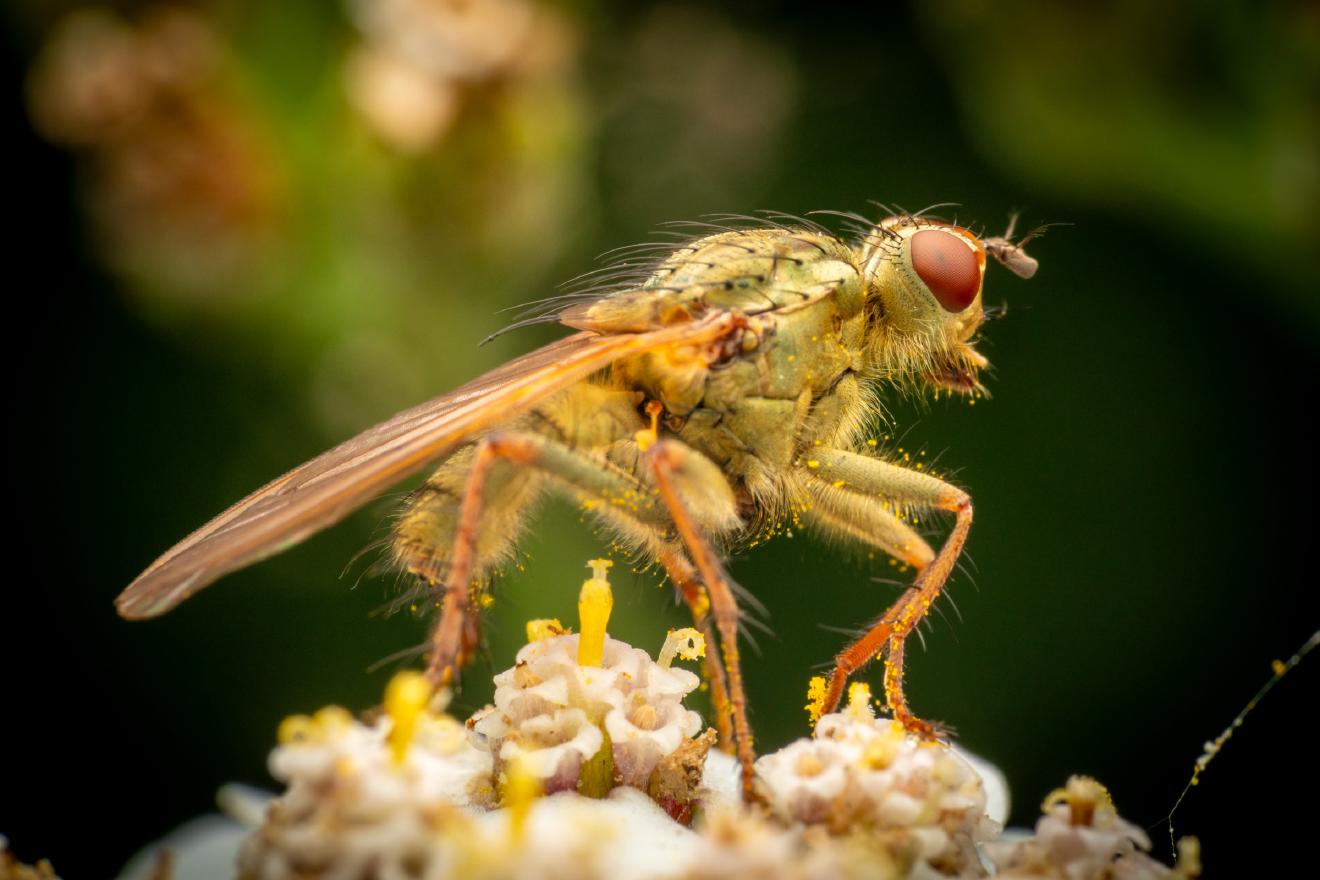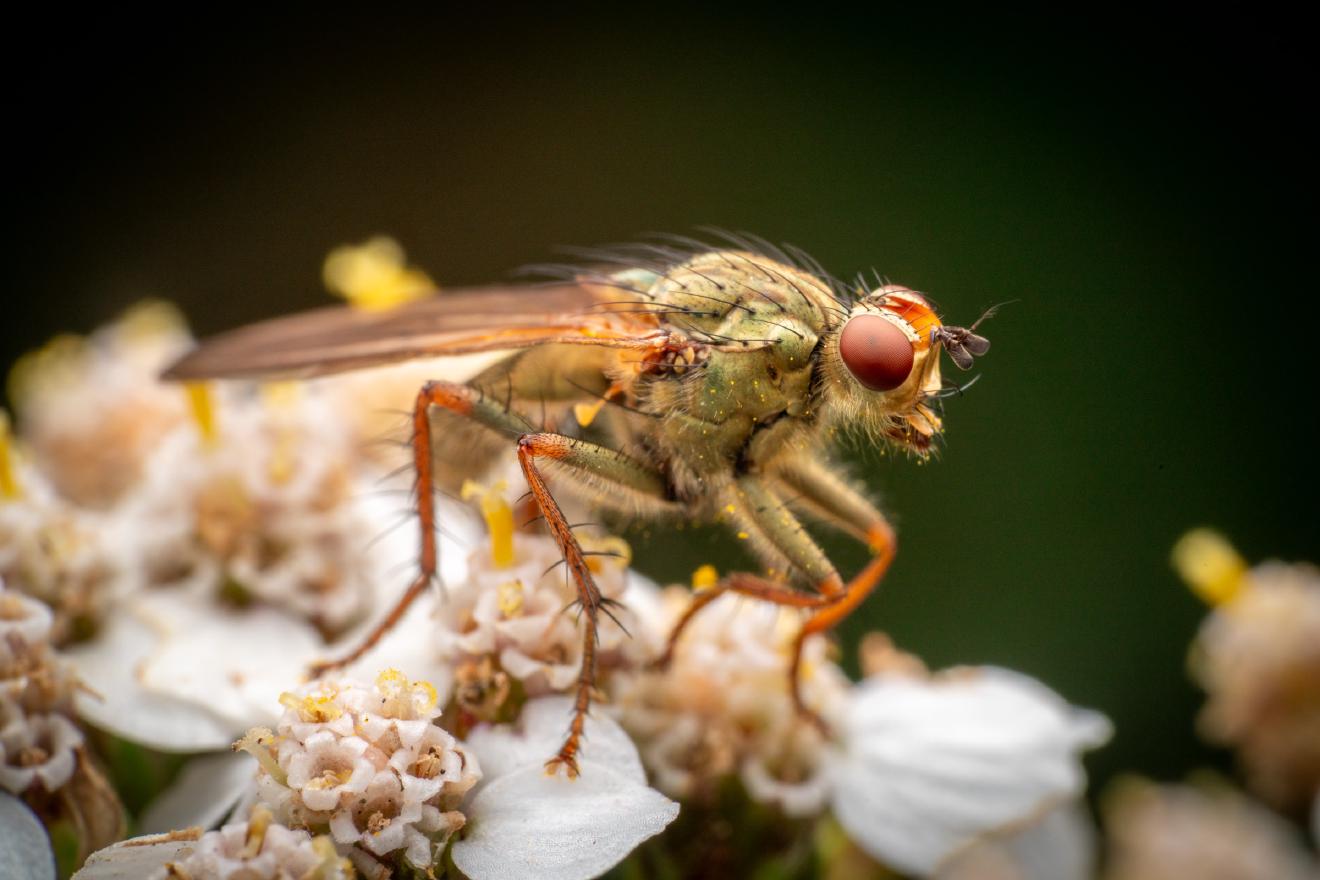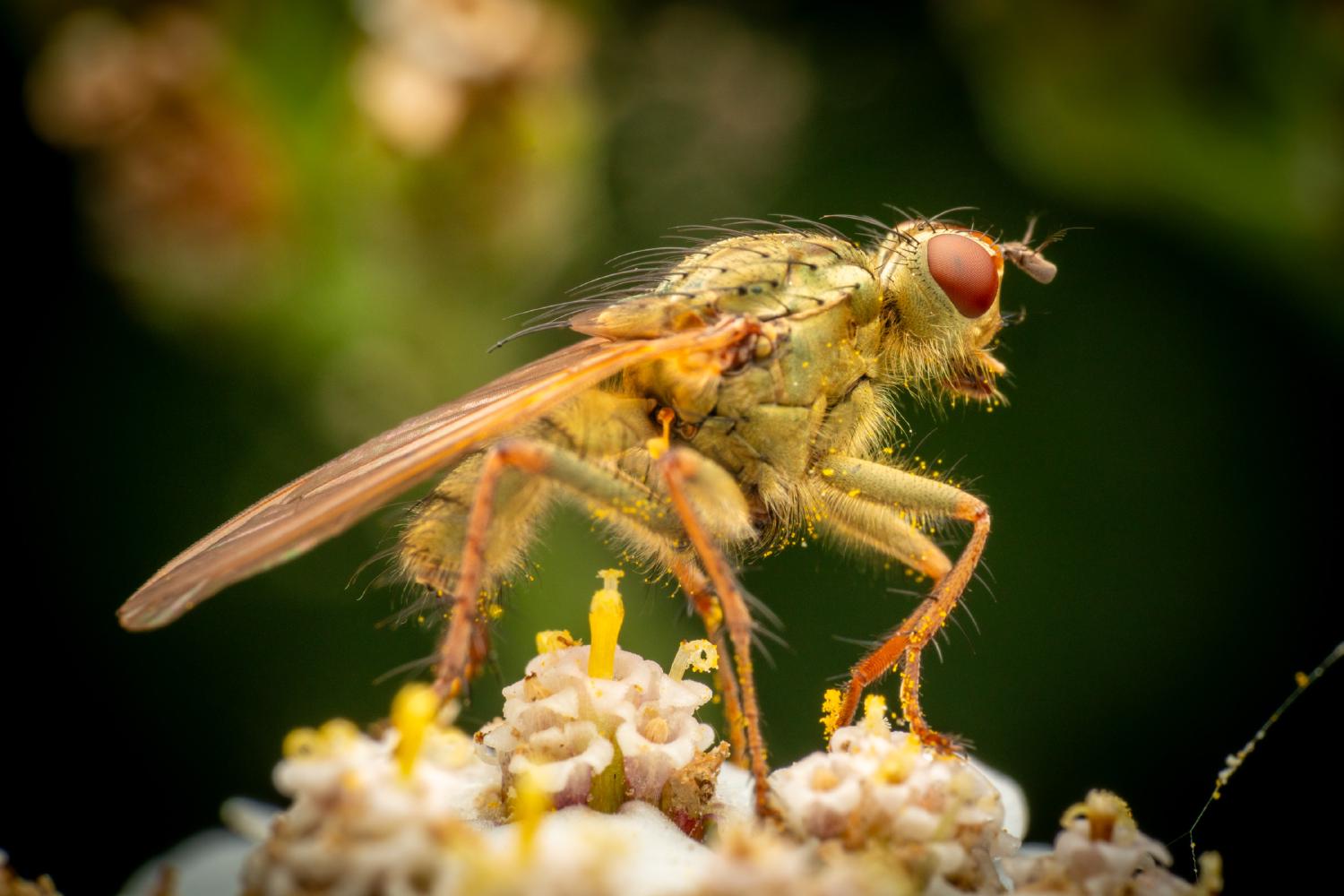Golden Dung Fly
Lat. “Scathophaga stercoraria“
species
of family
“Dung Flies“
1 species
Scathophaga stercoraria, also known as the yellow dung fly, is a sexually dimorphic species found in cooler temperate regions of North America, Asia, and Europe. The adult males have a bright golden-yellow color, while females are duller with green-brown tinges. They primarily feed on smaller insects and also consume nectar and dung. Their reproductive success depends on factors such as sperm competition, nutrition, and environmental temperature. The species has a short lifespan of one to two months and their life cycle involves laying eggs on dung, with larvae feeding and pupating in the soil. Yellow dung flies have phenotypic plasticity, with body size and development rate varying based on factors such as food availability and temperature. They can be preyed upon by birds, bats, and other insects. The yellow dung fly is used as a model organism for various research studies, including reproductive physiology, genetics, and ecotoxicology. It plays a crucial role in decomposing waste in pastures, contributing to nutrient recycling and reducing pest fly populations. However, the use of veterinary drugs in livestock can have unintended adverse effects on yellow dung fly populations if not monitored carefully.
Description
Scathophaga stercoraria is sexually dimorphic, with an average lifespan of one to two months. The adult males are bright golden-yellow with orange-yellow fur on the front legs. Females are a little duller in color, with pronounced green-brown tinges, and no brightly colored fur on the front legs. The adults range from 5 to 11 mm in length, and the males are generally larger than the females. The physical features of separate S. stercoraria populations can vary greatly, due in part to the range of locations in which the species is found. Generally, they are located in cooler temperate regions, including North America, Asia, and Europe. They may also favor higher altitudes, such as the Pyrenees and Swiss Alps.
Feeding
The adults mainly prey on smaller insects, mostly other Diptera. They can also consume nectar and dung as additional sources of energy. In a laboratory setting, adult S. stercoraria can live solely on Drosophila and water. Females spend most of their time foraging in vegetation and only visit dung pats to mate and oviposit on the dung surface. Both males and females are attracted to dung by scent, and approach dung pats against the wind. Males spend most of their time on the dung, waiting for females and feeding on other insects that visit the dung, such as blow flies. In the absence of other prey, the yellow dung fly may turn to cannibalism. The larvae are coprophagous, relying on dung for nutrition.
Reproduction
Scathophaga stercoraria breeds on the dung of many large mammals, but generally prefers fresh cattle dung. The operational sex ratio on these pats is very male-biased and competition is high. Females are small and have limited precopulatory choice. Copulation lasts 20–50 minutes, after which the male attempts to guard the female from other males. Both males and females often mate with multiple partners. Reproductive success depends on a variety of factors, including sperm competition, nutrition, and environmental temperature.
Life cycle
The eggs that the female lays on the dung hatch into larvae after 1–2 days, depending on temperature. The larvae quickly burrow into the dung for protection and feed on it. At 20 °C, larvae undergo three molts over five days, during which they grow exponentially. After growth, larvae spend another five days emptying their stomachs before pupation, where no additional body mass is gained. After 10–20 days, the larvae burrow into the soil around and beneath the dung and pupate. The time needed for the juvenile flies to emerge can vary from 10 days at 25 °C to 80 days at 10 °C or less. The smaller females typically emerge a few days before the males. The fitness of the resulting juveniles is greatly dependent on the quality of the dung in which they were placed. Factors affecting dung quality include water content, nutritional quality, parasites, and drugs or other chemicals given to the animal. Yellow dung flies are anautogenous. To become sexually mature and produce viable eggs or sperm, they must feed on prey to acquire sufficient proteins and lipids. Females under nutritional stress will have higher rates of egg mortality and less survival of offspring to adult emergence. S. stercoraria females can then produce four to 10 clutches in their lifetimes. The adults are active throughout much of the year in most moderate climates.
Phenology
Yellow dung fly viability depends strongly on the environment. In warmer climates, a sharp population decline often occurs in the summer, when the temperatures increase above 25 °C. Meanwhile, no population decline is seen in colder climates, such as Iceland, Finland, and northern England, and high elevations. Additionally, the number of generations per year varies with altitude and latitude, typically between two and four overlapping generations. The end of winter synchronizes the first emergence in March, and the overwinter generations are produced in the fall. In northern Europe, where the mating season is shorter, only one or two generations can be expected.
Phenotypic plasticity
Yellow dung flies have extremely variable phenotypes – body size and development rate in particular. Proximate causes of variation include juvenile nutrition, temperature, predation, and genetic variation. Much phenotypic plasticity in yellow dung flies is a result of food (dung) availability in the larval stage, which is often mediated by conspecific competition. Less dung results in more competitors, and more drying results in decreased growth rate and adult body size. Additionally, when exposed to constant temperatures in a laboratory setting, higher temperatures during growth yield smaller flies. Egg volume, but not clutch size, also decreases with increasing temperature. Giving merit to the hypothesis that constraints on physiological processes at the cellular level account for temperature-mediated body size, studies have also shown that S. stercoraria body size varies via gene-by-environment interactions. Different cell lines vary significantly in growth, development, and adult body size in response to food limitation.
Parasites and diseases
Since S. stercoraria is a synanthropic fly, it does carry the risk of passively contaminating human food with various pathogens, molds, or yeasts.Some sexually transmitted diseases of insects are known, particularly in Coleoptera. Similar diseases have also been studied in S. stercoraria. Many of these sexually transmitted diseases are from multicellular ectoparasites (mites), protists, or the fungus Entomophthora muscae. These are frequently responsible for either sterilizing or killing the host fly.
Predators
As well as being an easy meal for a great many bird and bat species, these flies are also preyed upon by other insects. Much competition exists between larvae of different species within a dung pat. Other insect species may also use the pats as hunting grounds. These include robber flies and clown beetles.
Use as a model organism
Like Drosophila melanogaster, the yellow dung fly is an ideal model organism due to its short lifespan and susceptibility to various experimental manipulations. Initial interest in yellow dung flies came from their potential as biocontrol agents against pest flies around livestock. In the past 40 years alone, many studies have used S. stercoraria to research topics such as sperm competition, mating behavior, sexual conflict, reproductive physiology, thermal biology, and genetics. In particular, research on yellow dung flies has contributed greatly to understanding of multiple mating systems and sperm competition. Recently, S. stercoraria was approved as a standard required test species for ecotoxicological testing. This includes evaluating the residues of veterinary drugs in livestock dung. Yellow dung flies are a key part of decomposing waste in pastures, which is key to preventing the spread of endoparasites and returning nutrients to the soil. The species’ diet also serves to reduce the abundance of pest flies. To test a chemical’s toxicity, the chemical is mixed with bovine faeces, to which yellow dung fly eggs are added. Then, endpoints, such as sex and number of emerged adult flies, retardation of emergence, morphological change, and developmental rate, are measured and analyzed to determine toxicity. A great deal of research has been done on the effects of avermectins on populations of S. stercoraria. Avermectins are used to control endoparasites in livestock. The resulting dung contains drug residues that can have unintentional adverse effects on yellow dung fly populations, such as increased mutations and decreased offspring viability. If the use of such drugs in agriculture is not carefully monitored, considerable economic losses could occur.
External links
Media related to Scathophaga stercoraria at Wikimedia Commons
Jim Lindsey’s page on yellow dung flies University of Paisley Scathophaga stercoraria site


Ancestry Graph
Further Information
Copyright

This article uses material from the Wikipedia article Scathophaga stercoraria the free encyclopedia Wikipedia which is released under Creative Commons Attribution-ShareAlike 4.0 International License). On Wikipedia a list of authors is available.
